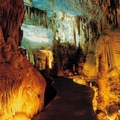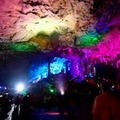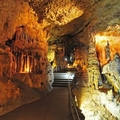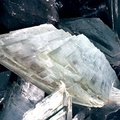Eco-friendly locations / The Most Beautiful Caves and Grottos of the World / Sof Omar Caves, Ethiopia
Sof Omar Caves, Ethiopia
If you look at caves in terms of geology, they represent only a cavity in the earth's crust, but the caves have played an important role in the development of humanity, and through fear of the unknown the man hasn’t studied thoroughly many of the caves of the planet. Many caves have survived the so-called "rock" pictures of the first people that make it possible to understand the life and culture of the ancient inhabitants of the earth. Many caves are interesting and varied for their interior.
Description of the Cave
The Sof Omar Caves have a length of 15.1 km (9.5 miles), making them the longest cave system in Ethiopia. A source claims that this system is the largest in Africa. The caves are located in Bala in the south-eastern Ethiopia , where flows the Web River. Log opens in Ive Mako and reappears at a distance of 1 km in Holuke. For a long time the cave was a religious center and it is a sacred place for the local and traditional religions and Islam. The caves are known by many posts, especially those that are located in the "House of the Colon." According to a tradition, Sof Omar was the name of a Muslim saint who lived in the area, and Ive was the name of his daughter. Mako and Holuka are the local names for "caves". The researcher Arthur Donaldson Smith recorded the visit to the cave in 1897. An Italian expedition also visited the cave in 1913. In 1934, Henry Bryuil spent some archaeological research in the field. The Italians almost certainly visited the cave during the years of occupation, but apparently none of these early researchers did not pass on to Holuke Ive Mako. In 1967, Eric Robson, Chris Klafem Kabir Ahmed explored and discussed, and the cave, made a record 8 km of passage. After this, the Ethiopian Tourist Board has published a brochure about the cave. Although the area is not readily available and the tourist industry has not been extensively developed in the area, a few intrepid visitors made the trip to the then remote cave. In February 1971, Professor Theodore Monod from the National Museum of Natural History of France, Bill Morton (University of Manchester Speleology, Caves Research Society), and Ato Mazhmar Hsilemalid recorded another-km new passage in the famous cave. The same year Dick Ashford and Malcolm Hale Larga Selassie made a study of caves and some species of bats living in a cave. In 1972, the British expedition arrived in Ethiopia. The team included Dick and Tim Remsden Renvozi (Speleology Club of Preston), Simon Amatt (Birmingham Karabinersky Club), Dave Catlin (Club Bradford University), Paul Remsdena (Center for the Boy Scouts Vernsayd), Terry and Steve Raynor Vorzingtona (Sheffield University Speleological Society).With some initial help from Bill Morton's group made a systematic study and review of the cave, and published the full report, "Sof Omar Caves and Ethiopia" Cave Research Group of Great Britain. The team found 6.1 km of new passages, bringing the total number of survey length 1.15 km. Sof Omar has 42 inputs, but in general, only four of them are suitable to enter the cave safely. The House of the Colon is a unique feature in the world of caves.
Maps of Sof Omar Caves, Ethiopia
map EthiopiaOthers from The Most Beautiful Caves and Grottos of the World
Do we know everything about this world? Of course not, and the most interesting thing is that we know a little about what is on the surface of this planet, but nothing is really aware of the fact of what is at the bottom, below the surface.
But underground there are many wonderful things, in particular, the caves, which keep their secrets from us humans.
I want to present to you, dear readers, the most interesting and the most beautiful caves of our world.
From childhood we are taught that there are caves with stalactites and stalagmites that have formed over centuries, millennia draining down water - drop by drop, and on the ceiling and the floor of the cave gradually formed tumors by mineral particles contained in water.
Caves are subterranean voids that were formed by leaching of soft rocks, tectonic processes, etc.
There is unique fauna in the caves, which members have developed other ways of feeling and movements due to the absence of light.
Each cave is a special world, where you can see its beauty.
Thus, the Onogonda Caves from Missouri and the Red Flute Cave of Canada are known for their stalactites and stalagmites.
The last was named so because the whole cave has excellent acoustic properties, and despite its length of 240 meters, the flute is perfectly audible from end to end.
There also are icy caves where there is plenty of both ice and fire.
The ceilings of some caves are completely covered with ice, and at the bottom some lava flows.
Such caves can be found in Vietnam, Scotland and Norway, respectively.
Cavity: the real meaning of peace Cavities are formed by water, which create enormous empty spaces below the surface, washing out the breed for millennia.
Few countries can boast such caves, the cave Deer, known as the longest mall in the world.
A closer example, the Hugden Grotto, known for its waterfalls and in Slovenia Skocjan equally beautiful and frightening.
Man slightly ennobled them, sheds and bridges were conducted under ground electricity, but it further emphasizes the wild nature of these caves.
Morokkan cave in North Africa is probably the most unusual and beautiful cave in the world.
The thing is that in the vault of this cave is a hole, through which the sun looks periodically.
People took it as marked by God for a long time because what else enters the cave beside the sun? Caves are places of mystery, paradox and beauty.
Find out which are the most amazing and famous caves and grottos in the world created by nature.
















